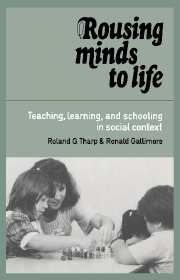Book contents
- Frontmatter
- Contents
- Acknowledgments
- Introduction
- Part I Teaching, schooling, and literacy: a unified theory of education
- Part II Practice
- 6 A school organized for teaching: the Kamehameha Elementary Education Program
- 7 The activity setting of the instructional conversation: developing word and discourse meaning
- 8 The orchestration of activity settings: learning and social interaction in the whole group and independent centers
- 9 The interpsychological plane of teacher training
- 10 Assisting teacher performance through the ZPD: a case study
- 11 The intrapsychological plane of teacher training: the internalization of higher-order teaching skills
- 12 The schools in mind and society
- References
- Author index
- Subject index
7 - The activity setting of the instructional conversation: developing word and discourse meaning
Published online by Cambridge University Press: 05 June 2012
- Frontmatter
- Contents
- Acknowledgments
- Introduction
- Part I Teaching, schooling, and literacy: a unified theory of education
- Part II Practice
- 6 A school organized for teaching: the Kamehameha Elementary Education Program
- 7 The activity setting of the instructional conversation: developing word and discourse meaning
- 8 The orchestration of activity settings: learning and social interaction in the whole group and independent centers
- 9 The interpsychological plane of teacher training
- 10 Assisting teacher performance through the ZPD: a case study
- 11 The intrapsychological plane of teacher training: the internalization of higher-order teaching skills
- 12 The schools in mind and society
- References
- Author index
- Subject index
Summary
Assistance to the developing child occurs in activity settings: Who is with the child to provide assistance, what they are doing (and the rules or scripts that govern how participants conduct themselves), and when, where, and why they are doing it – these define the activities in which cognition develops. Assisted performance occurs in these activity settings' interpersonal transactions and in the context of their intersubjectivity. The task of designing systems for assistance is that of designing activity settings. The criterion for an educationally effective activity setting is that it should allow a maximum of assistance in the performance of the tasks at hand. The activity setting is a unit of analysis that transcends individuals and provides a meaningful way to integrate culture, local contexts, and individual function (Cole, 1985; Rogoff, 1982; Weisner, 1984; Weisner & Gallimore, 1985; Weisner et al., 1986).
Like all institutions, schools are constituted of activity settings: The classroom, playground, cafeteria, nurse's office, and auditorium evoke, even in aging graduates, images of place and event. These shared memories reflect school activity settings that have been as stable as a rock and have been sources of dismay to succeeding generations of reformers. To secure change requires that the school's activity settings be understood and be altered so that they will give rise to the desired assistance of performance.
We begin our analysis of the school's activity settings with those that are closest to education's final common pathway – those of the classroom itself.
- Type
- Chapter
- Information
- Rousing Minds to LifeTeaching, Learning, and Schooling in Social Context, pp. 130 - 160Publisher: Cambridge University PressPrint publication year: 1989



